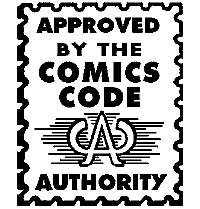 Last week, CBLDF announced it had acquired the rights to the Comics Code Authority Seal, marking the end of the censorship the seal once represented. After the announcement, CBLDF Executive Director Charles Brownstein spoke with Vaneta Rogers at Newsarama about the acquisition.
Last week, CBLDF announced it had acquired the rights to the Comics Code Authority Seal, marking the end of the censorship the seal once represented. After the announcement, CBLDF Executive Director Charles Brownstein spoke with Vaneta Rogers at Newsarama about the acquisition.
Several reports mistakenly indicated that CBLDF purchased the rights to the seal, a misconception Brownstein cleared up when Rogers asked him about the acquisition:
“As the Comic Magazine Association of America, was winding down they approached us to inquire whether we would be interested in receiving the Seal of Approval,” Brownstein told Newsarama. “Through a brief, and fairly straightforward process, they assigned us the rights to the Seal for use as part of our fundraising and education program. It was a donation from the industry’s dying self-censorship body to assist its mature First Amendment defense body.”
Rogers also described the conflicted nature of the seal, indicating that the seal both saved comics and established the misconception that comics are only for children. She asked Brownstein for his take:
“I think it’s fair to say that the Code did save comics, but it did so by introducing a regime of censorship that put creators and publishers out of work, and thoroughly infantilized what the medium had to say in a way that lasted for generations,” Brownstein said. “In the days of the Code, the argument that comics had First Amendment value was a non-starter, and the path to survival was self-censorship. Those days are a brutal illustration of how creativity can be crushed by the forces of moral panic.”
Rogers went on to ask Brownstein about contemporary rating systems and how they compare to the oppression of the Comics Code seal:
“The Comics Code was a compulsory measure administrated by an external body that publishers had to adhere to in order to obtain distribution. The modern day publisher ratings are voluntary, self-guided measures that each publisher administrates internally to help provide guidance to retailers and parents about the content of their work,” Brownstein said. “The difference between the Code and modern day ratings is the difference between an outside body governing what publishers can say before their content goes to market and the publisher itself putting work into the market with guidance for retailers and audience.”
During the interview, Brownstein discussed his personal feelings about the seal:
And the symbol isn’t all “bad,” Brownstein admitted. “The Code has enormous sentimental nostalgia value for two or three generations of readers who read comics with the seal on the cover,” he said. “When I was a kid, before I had any idea of the history, I knew that all the comics I bought had this seal on the cover and I associated it with the good feelings I had about comics. I think there are a lot of people who have warm feelings towards the seal for similar reasons. Being able to use the seal to introduce them to the CBLDF’s work protecting comics is a positive thing.”
You can read the entirely of Rogers’ interview with Brownstein here.
Be Counted and support CBLDF’s First Amendment legal work by bidding on original artwork, making a donation, or becoming a member of the CBLDF!